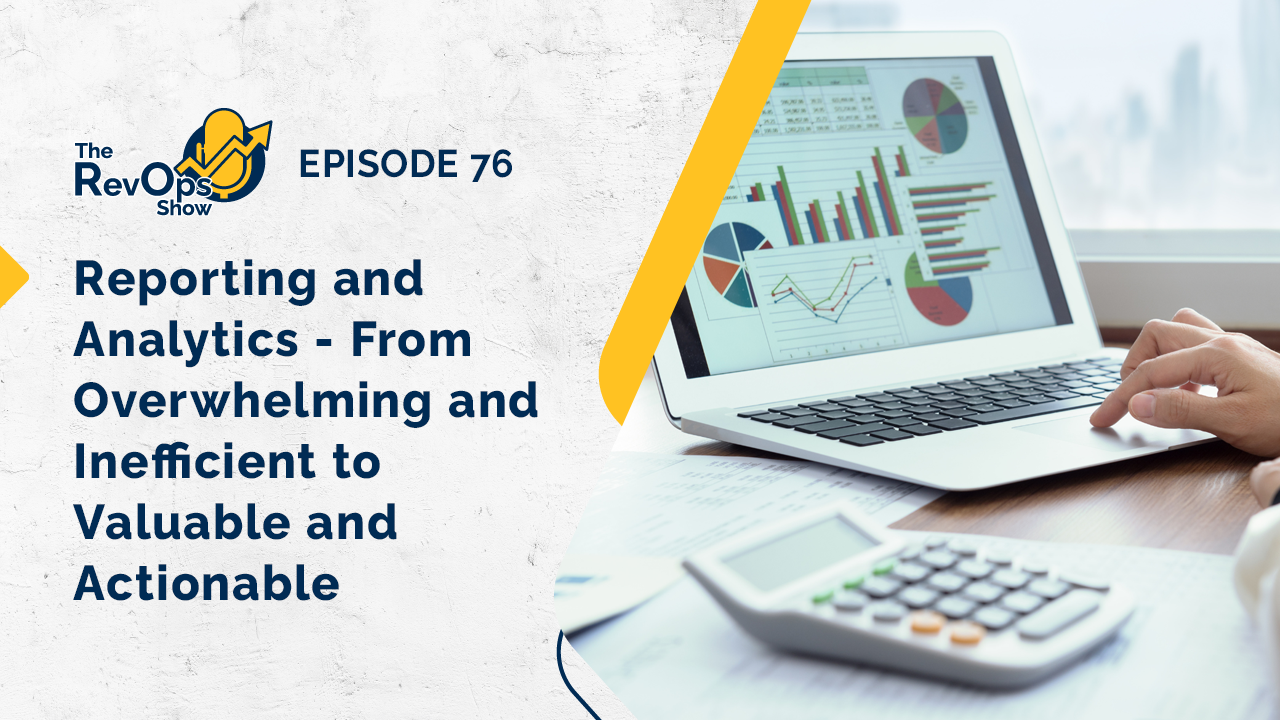It’s easy to set up reports today, leading to inefficient and confusing data instead of clarity and alignment. Doug and Jess talk through how we should view and think about data and analytics and some common mistakes made when creating reports.
Audio:
Video:

Additional Resources:
- [RevOps Show] Episode 26: What (Almost) Everyone is Getting Wrong with Data & Metrics
- [RevOps Show] Episode 65: The Power of Data Integration: Building a Reliable System of Record for Efficient Decision-Making
- [Blog] What it Means to be Data-Driven, How It’s Different from Metrics & How to Apply it
- [Blog] Organizing Your Data Junk Drawer
Show Notes:
Editor’s Note: This episode was recorded on Halloween, so we’re taking a trip back in time for this one.
Pre-Show Banter: Doug and Jess talk about Halloween and what everyone is going as. Jess is going as a tired mom and Doug doesn’t participate in Halloween like he used to. Doug also mentions a funny insurance commercial featuring Travis Kelce.
Today’s topic of discussion revolves around how the more and easier reporting becomes, the less efficient and more expensive it becomes. Doug and Jess also hit on some common mistakes made when setting up reports.
The goal of reporting metrics and analytics is to separate the signal from the noise and to gain actionable insights. Reporting provides a picture of what is happening in different areas of a business. Reports and dashboards should provide value by either providing an intervention, context, or an answer to a question.
- An intervention here refers to taking action or making a change based on the information presented.
- Context involves understanding where the organization is in relation to its plans or goals and how it’s performing.
Reports and dashboards should enable better questioning and thinking, rather than replacing thinking entirely. Rather than looking for answers to questions as the end-all-be-all, your reports should provide insights to help inform future decision making.
When you’re looking at averages in reports, say a trends report for example, they can hide the truth and be misleading. Averages may be factually correct, but can be wrong in terms of representing the whole picture. For instance, disproportionate sales can skew average sales value and hide a degradation of value.
A good dashboard should have a clear purpose and align with the goals and strategy of the organization. They should group together a series of reports that are relevant to each other and provide valuable insights. Also note that measuring too much can lead to noise and confusion, making it difficult to find meaningful insights. That’s why metrics and data should be used as a support for decision-making - not as the sole driver.
Being data driven doesn’t mean blindly following what the data tells us, but rather using the data to inform and guide decision-making.
The biggest value of metrics is finding surprises or unexpected results. Looking to see what surprised you or what wasn’t expected oftentimes leads to the best outcomes and insights.
Nowadays, it has become easier than ever to create a report, and many companies have so many that it leads to information overload. Every time someone looks at data, it acts as a stimulus. From there people will look for something to do off of the stimulus. Sometimes the best action after looking at data is to do nothing.
Doug used to believe in letting everyone see their data. He now believes that it’s not necessary for everyone to have access to all data because the goal isn’t to increase visits or conversions, for example, but to have impact.
Reports and dashboards should come from a clear strategy and should have a strong hypothesis behind them or a job to support their purpose. It’s important to regularly evaluate if the reports/dashboards are still providing accurate and valuable insights. You also want to define objectives for the reports and consider the audience for each to tailor the content to the person viewing the report/dashboard.
Reporting is an important aspect of revenue operations, where requests for specific metrics are evaluated for alignment with the strategy. Constraints and boundaries should be established to ensure meaningful and valuable insights are derived.
Data from the past cannot precut the future, so use your data as a guide for future decision-making.
Jess’s Takeaways:
- Reporting left on its own leads to averages which are normally not accurate
- You need to define what you want your dashboard to do or have a strong hypothesis
- When setting up your dashboards, the biggest value of metrics are identifying the surprises
- In order to get the most value out of your dashboards and reports, you have to have constraints
Next Steps:
-
Follow Jess, Doug & Lift on socials for updates on the show or other insights:
-
Doug Davidoff: Twitter/X - @dougdavidoff | LinkedIn
-
Jess Cardenas: Twitter/X - @JessDCardenas | LinkedIn
-
Lift Enablement: Twitter/X - @DemandCreator | LinkedIn
-
-
Subscribe to the show on Spotify & Apple Podcasts
-
Check out Let's Play RevOps on Twitch for more commentary on this topic
-
Listen to Episode 77: Always Be Launching - The Key to CRM Success
